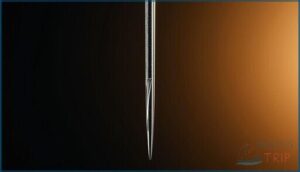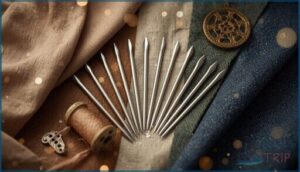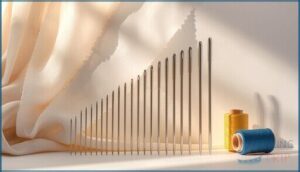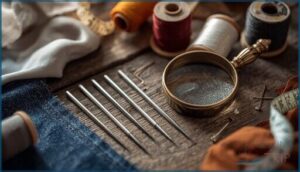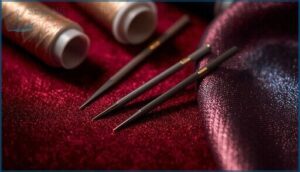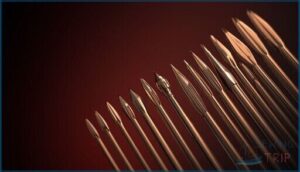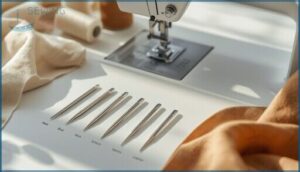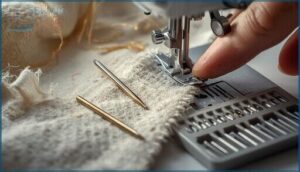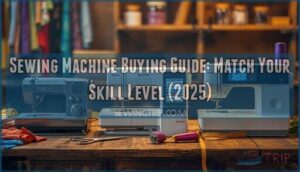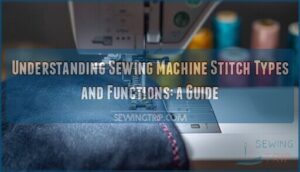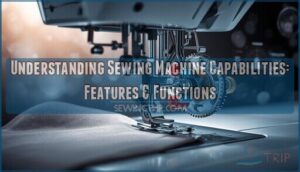This site is supported by our readers. We may earn a commission, at no cost to you, if you purchase through links.
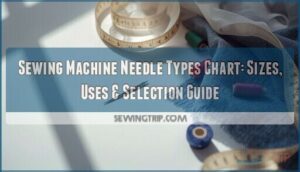
You thread your machine, slide your fabric under the presser foot, and press the pedal—only to hear that telltale clicking sound as the needle skips stitches or snags the fabric. Nine times out of ten, the culprit isn’t your machine or your technique. It’s the needle.
Most sewers learn this lesson the hard way, after wrestling with puckered seams on knits or broken threads on denim. The truth is, that little sliver of steel makes or breaks your project, and choosing the wrong one wastes time, fabric, and patience.
A sewing machine needle types chart takes the guesswork out of the process, matching the right needle to your fabric and thread in seconds. Once you understand how needle sizes, points, and specialty designs work together, you’ll stop fighting your machine and start enjoying the smooth, professional results you’ve been chasing.
Table Of Contents
- Key Takeaways
- Choosing The Right Sewing Machine Needle
- Sewing Machine Needle Types Chart Explained
- Understanding Sewing Machine Needle Parts
- Types of Sewing Machine Needles for Specific Fabrics
- Sewing Machine Needle Sizes and Their Meanings
- How to Select The Best Sewing Machine Needle
- Specialty Sewing Machine Needles for Unique Tasks
- Are Sewing Machine Needles Universal and Interchangeable?
- Essential Sewing Machine Needles to Keep on Hand
- Maintaining and Replacing Sewing Machine Needles
- Frequently Asked Questions (FAQs)
- Conclusion
Key Takeaways
- Matching your needle to fabric weight and thread type prevents most common sewing problems like skipped stitches, puckering, and thread breakage—lightweight fabrics need fine needles (60/8–70/10), medium fabrics work with 80/12–90/14, and heavyweight materials require stouter sizes (100/16–110/18).
- The needle’s anatomy matters more than most sewers realize, with each part playing a specific role—the eye must match thread thickness, the scarf creates the loop formation zone for your machine’s hook, and the point geometry determines whether you’ll damage delicate knits or cleanly pierce dense wovens.
- Universal needles handle everyday woven and light knit fabrics, but specialty needles exist for good reason—ballpoint tips glide between knit fibers without snagging, sharp points deliver precision on delicate wovens, and reinforced denim needles punch through heavy layers without deflecting or breaking.
- Replace your needle every 6–8 hours of sewing even if it looks fine, because microscopic dulling affects stitch quality long before you see visible damage, and a worn needle shows warning signs like skipped stitches, thread breakage, fabric snags, or unusual clicking sounds.
Choosing The Right Sewing Machine Needle
Picking the right needle isn’t guesswork—it’s about matching what you’re sewing with what you’re sewing it with. Your fabric’s weight and the thread you choose work together to determine which needle will give you clean, professional stitches.
Let’s look at the key factors that’ll help you make the right call every time.
Considering Fabric Weight and Thread Type
When you pair the wrong needle with your fabric weight and thread type, you’re inviting seam failures and thread tension headaches. Start by checking your fabric’s GSM—lightweight materials around 30–150 GSM need finer needles (size 60/8–70/10), while heavyweight fabrics over 350 GSM demand stouter sizes (100/16–110/18) to prevent needle deflection. A key element involves understanding fabric and needle compatibility.
Here’s your quick matching guide:
- Light fabrics (silk, chiffon) → size 60/8–70/10 with fine thread
- Medium fabrics (cotton, linen) → size 80/12–90/14 with medium thread
- Heavy fabrics (denim, canvas) → size 100/16–110/18 with heavy thread
Factors Affecting Needle Selection
Machine compatibility matters more than most sewers realize—your needle system must match your machine’s hook timing, or you’ll face skipped stitches. Fabric structure guides point style: sharp points for wovens, ballpoint for knits to avoid snags. Needles with different point shapes are designed for different fabric types.
Seam type plays in too; topstitching demands specialized eyes that standard needles lack. Thread type influences everything—metallic threads need elongated eyes to reduce friction and breakage.
Seam type and thread choice dictate needle requirements—topstitching needs specialized eyes, while metallic threads demand elongated ones to prevent breakage
Sewing Machine Needle Types Chart Explained
If you’ve ever stood in front of a wall of needles, wondering which one won’t let you down, you’re not alone. That’s where a needle size chart steps in—think of it as your personal cheat sheet for sewing machine needle selection. With a quick glance, you’ll spot which needle type works best for your fabric, thread, and project.
For instance, universal needles cover most day-to-day sewing, while denim needles tackle thick layers without breaking a sweat. Curious how it all lines up? Here’s a handy table to guide you:
| Needle Type | Fabric Match | Common Sizes |
|---|---|---|
| Universal | Woven, light knits | 60/8–90/14 |
| Ballpoint | Jersey, knits | 70/10–90/14 |
| Denim | Canvas, jeans | 90/14–110/18 |
| Leather | Natural leather | 90/14–110/18 |
A clear needle types and uses chart keeps your sewing frustration-free.
Understanding Sewing Machine Needle Parts
If you’ve ever wondered what makes a sewing machine needle work so well, the answer lies in its design. Each part of the needle plays a specific role in creating clean, even stitches.
Let’s break down the key components you need to know.
The Role of The Butt and Shank
Think of the butt and shank as the anchor that keeps everything steady. The butt—that beveled top end—helps you insert the needle correctly into the needle bar, while the shank locks it in place.
Most household needle brands and models use a flat-sided shank to guide proper alignment timing with your machine’s hook. This structural support isn’t just about holding the needle; it directly affects how well your machine forms stitches.
When you understand needle anatomy and guarantee correct needle insertion, you’ll see fewer skipped stitches and smoother sewing overall.
The Function of The Blade and Grooves
Understanding needle anatomy means recognizing how blade diameter and groove dimensions work together. The blade’s long groove shields your thread during penetration—essential thread protection that prevents breaks. Meanwhile, the short groove on the opposite side aids loop formation, helping your machine’s hook catch smoothly. Refined designs improve these needle parts and function for reliable stitching:
- Blade diameter determines needle strength and rigidity
- Long groove width protects thread from friction
- Short groove enhances stable loop formation
- Proper groove dimensions prevent skipped stitches
- Improved needle geometry improves seam quality
The Importance of The Eye and Scarf
When you’re battling skipped stitches or thread friction, the needle eye and scarf are often your culprits—or your heroes. The eye geometry must match your thread thickness; a too-small eye shreds thread during high-speed runs, while the scarf creates the loop formation zone where your machine’s hook grabs each stitch.
Proper needle scarf depth prevents needle deflection from sabotaging seams on stretchy fabrics.
The Significance of The Point and Shoulder
Your needle point geometry shapes every stitch from the moment it breaks the surface. A sharp point slices cleanly through dense weaves, while a ballpoint nudges knit yarns aside without cutting—reducing fabric damage and runs.
The shoulder design controls penetration force and withdrawal friction, directly affecting stitch formation quality.
Match needle types and sizes to your fabric weight, and you’ll avoid skipped stitches, puckering, and thread breakage every time.
Types of Sewing Machine Needles for Specific Fabrics
Not all sewing machine needles are created equal, and choosing the right one makes all the difference in how your project turns out. Each needle type is designed with a specific purpose in mind, whether you’re working with stretchy knits, crisp wovens, or tough materials like leather.
Let’s break down the main needle types you’ll reach for most often and when to use them.
Universal Needles for General Sewing
Universal needles are your all-purpose workhorse, holding about 28% of market share because they genuinely work. With that slightly rounded tip, they handle both wovens and knits across size ranges from 60/8 to 120/19—though you’ll reach for 70/10, 80/12, and 90/14 most often.
Their fabric compatibility makes them perfect for everyday garment construction and craft projects, but swap them out after 6–8 hours of sewing to maintain performance.
Ballpoint Needles for Knit Fabrics
You want smooth stitches on jersey or fleece? Ballpoint needles are the secret. Their rounded tips glide between knit fabric loops instead of piercing them, preventing snags and skipped stitches.
Use size 70/10 for lightweight knits, 80/12 for mid-weight, and 90/14 for heavier sweaters. They fit most home sewing machines, work with standard threads, and deliver excellent stitch quality.
Replace them every 8 hours to keep your knit projects looking sharp.
Sharp Needles for Straight Lines and Delicate Fabrics
When precision matters, sharp needles deliver clean, straight stitches on delicate woven fabrics like silk, chiffon, and microfibers. Their fine points prevent fabric damage while ensuring stitch precision on lightweight materials.
Choose sizes 60/8 to 90/14 based on fabric thickness—smaller for ultra-fine textiles, larger for medium-weight delicates. Thread compatibility is key: match your thread weight to needle size for professional results that meet industry standards.
Specialty Needles for Leather, Denim, and Stretch Fabrics
When sharp needles can’t handle the job, specialty options step in. Leather needles feature wedge-shaped points that slice through hides cleanly—look for sizes 80/12 to 110/18 depending on thickness. Denim needles bring reinforced strength for heavy twill, while stretch needle designs protect elastic fibers with rounded tips.
Match these sewing machine needle types to your project:
- Leather point types cut through vinyl and suede without tearing
- Denim/jeans needles (90/14–110/18) penetrate multiple layers without deflection
- Ballpoint needle uses include jersey knits where you need to glide between fibers, not pierce them
Sewing Machine Needle Sizes and Their Meanings
Understanding needle sizes isn’t as confusing as it might seem at first glance. You’ll notice two numbers on every needle package, and each one tells a different story about what that needle can handle.
Let’s break down what these numbers mean and how they’ll guide you toward picking the perfect needle for your project.
European Vs American Needle Sizes
On every needle package, you’ll see dual markings like 80/12—that’s the European number paired with the American size. European sizes measure blade diameter in hundredths of a millimeter (so NM 80 = 0.80mm), while the American-sized system runs from 8 to 18 for home use. Industrial sizes push beyond that range.
The metric standardization back in 1942 replaced roughly 40 legacy designations, giving us today’s clean needle size chart. Your needle size guide and chart will show these size conversion pairs side by side.
Choosing The Right Needle Size for Your Fabric
Now that you know the sizing systems, let’s nail down fabric selection. Your needle size chart should guide every choice—lightweight fabrics like silk pair with 60/8 to 70/10 sizes, while medium cottons need 80/12 to 90/14. For heavyweight denim and canvas, reach for 100/16 to 110/18.
Follow this fabric weight guide for proper thread-needle pairing:
- Chiffon and organza demand 60/8 needles with fine threads
- Cotton shirting uses 80/12 for balanced tension
- Quilting layers require 90/14 to prevent deflection
- Denim needs 100/16 to support topstitching thread
- Canvas demands 110/18 for stable penetration
Test stitching on scraps prevents damage before committing to your project.
How to Select The Best Sewing Machine Needle
Picking the right needle isn’t guesswork—it’s about matching three key things: your fabric, your thread, and the job you’re doing.
Get one of these wrong, and you’ll end up with skipped stitches, broken thread, or fabric that looks like it went through a battle.
Let’s break down exactly how to pair your needle with what you’re sewing.
Considering Thread Weight and Type
Thread weight and thread selection are closely related. Fine threads (60–100 wt) require smaller needles, such as 60/8 to 80/12, while heavy threads (20–30 wt) need larger needles, ranging from 90/14 to 100/16.
Thread weight also impacts thread compatibility. Polyester threads offer greater strength and can tolerate tighter tensions compared to cotton threads. Metallic threads, in particular, require special attention; they should be used with metallic or topstitch needles (80/12–90/14) to prevent thread breaks.
For precise matching of embroidery thread weight to needle size, consult needle-thread charts to ensure compatibility with your specific thread type.
| Thread Weight | Recommended Needle Size |
|---|---|
| Fine (100–60 wt) | 60/8–80/12 |
| Medium (50–40 wt) | 80/12–90/14 |
| Heavy (30–20 wt) | 90/14–100/16 |
| Metallic (40 wt) | 80/12–90/14 (metallic/topstitch) |
Matching Needle Size to Fabric Thickness
When you match needle size to fabric thickness, you’re setting yourself up for smooth, professional results. A Fabric Weight Guide or Needle Size Chart takes the guesswork out of needle selection, helping you prevent damage and maintain excellent stitch quality every time.
Here’s a quick Thickness Measurement reference for sewing machine needle sizes:
- Delicate fabrics (organza, lace): 8/60 or 9/65
- Lightweight fabrics (cotton lawn, chiffon): 10/70 or 11/80
- Medium-weight fabrics (quilting cotton, linen): 12/80 or 14/90
- Heavy-weight fabrics (canvas, denim): 16/100 or 18/110
- Extra-heavy fabrics (thick leather, upholstery): 19/120 or 20/120
Pairing the right sewing machine needles with fabric weight ensures your projects turn out beautifully without skipped stitches or thread breakage.
Specialty Sewing Machine Needles for Unique Tasks
Some sewing projects require needles that go beyond the basics. When you’re working with tricky materials like metallic threads or high-performance stretch fabrics, standard needles just won’t cut it.
Let’s look at two specialty needles that can make these challenging tasks much easier.
Metallic Needles for Embroidery and Decorative Stitches
When metallic thread shreds mid-project, you’re likely missing one key component: a metallic needle. These specialty sewing machine needles feature an elongated eye—about 20–30% larger than standard types—so delicate foil-wrapped threads glide through without breaking during machine embroidery. Titanium or gold coating benefits extend needle life several times over in high-stitch designs, while the deeper groove prevents thread shredding.
For sewing machine needle selection with industrial setups, pair these machine embroidery needles with reduced speed (350–400 stitches/minute) and tension calibration around 1.0–2.0 to prevent speed impact issues. Your decorative stitches will shine—literally.
| Feature | Why It Matters |
|---|---|
| Enlarged eye | Reduces friction on metallic threads |
| Specialized coating | Extends needle lifespan in dense embroidery |
| Rounded point | Protects delicate metallic foil wraps |
| Size 90/14 recommendation | Best for standard 40-weight metallic threads |
Stretch Needles for Knit and Stretch Fabrics
When your ballpoint needles skip stitches on spandex leggings, stretch needles are the fix. Their deeper scarf places thread closer to the hook, cutting missed stitches by roughly 40% on elastane blends.
Here’s why needle selection matters for knit fabrics:
- Medium ballpoint tip won’t snag jersey fibers
- Reinforced blade resists needle bending at speed
- Shorter eye controls thread on elastic materials
- System 130/705 H-S fits most machine systems
You’ll see improved seam appearance and fewer frustrations on stretch fabrics.
Are Sewing Machine Needles Universal and Interchangeable?
You might assume that all sewing machine needles work the same way across different machines, but that’s not quite the full picture. While many needles share a similar design, compatibility depends on your machine’s brand and system type.
Let’s clear up what “universal” really means and what factors determine whether you can swap needles between machines.
Understanding Needle Compatibility
Most home sewing machines rely on the 130/705 or HAx1 system identification, featuring a flat-backed shank that ensures brand interchangeability across Schmetz, Organ, and similar manufacturers. When selecting needles, proper orientation matters—the flat side usually faces back, preventing skipped stitches and breakage.
Installation height and secure clamping are equally important for sewing performance. Needle size must align with both fabric weight and thread weight; a 70/10 works beautifully for lightweight cotton, while denim demands a sturdy 100/16.
This fabric compatibility and thread compatibility pairing isn’t just technical—it’s the difference between smooth stitching and frustrating thread shredding.
Factors Affecting Needle Interchangeability
Think of needle interchangeability as a puzzle—shank geometry and system standards must align perfectly. While most home machines accept 130/705 H needles from any brand equivalence, hook timing depends on precise needle size and needle types.
Industrial machine type requirements differ entirely, so your trusty needle chart becomes essential. Check your needle guide before swapping; even compatible needle selection can fail if the system doesn’t match your specific setup.
Essential Sewing Machine Needles to Keep on Hand
You don’t need a drawer full of every needle ever made, but having a few key types on hand will save you time and frustration. Think of it as your needle starter kit—the essentials that cover most everyday sewing situations.
Let’s look at which brands are worth trusting and which needle types you’ll actually reach for again and again.
Brands of Sewing Machine Needles
When you’re choosing needle brands, trust matters—especially with counterfeit needles flooding the market. Schmetz leads globally with unrivaled needle innovation and market share, while Organ Needle and Groz-Beckert dominate industrial sewing with proven durability. Regional availability varies, so you’ll want to:
- Check brand reputation through sewing communities and reviews
- Compare needle brands and quality for your specific machine
- Stock multiple brands to match fabric demands
Smart needle selection means investing in reliable brands that deliver consistent results every time.
Needle Types for Common Sewing Tasks
Your best needle selection starts with these workhorse types you’ll reach for constantly. Universal needles handle most cotton and poly blends, ballpoint benefits knit fabrics by preventing snags, and sharp applications shine on wovens requiring precision.
Check this needle chart for fabric types:
| Needle Type | Best For | Size Range |
|---|---|---|
| Universal | Cotton, poly blends | 70/10–90/14 |
| Ballpoint | Jersey, knits | 70/10–90/14 |
| Sharp | Woven specialty fabrics | 60/8–90/14 |
Needle compatibility matters—keep these three types stocked for smooth sewing machine needle types coverage.
Maintaining and Replacing Sewing Machine Needles
Even the best needle won’t last forever, and knowing when to swap it out can save you from frustration and botched projects. A worn-out needle shows warning signs that are easy to spot once you know what to look for.
Let’s cover how to tell when your needle’s past its prime and the simple steps to replace it properly.
Signs of a Worn-Out Needle
How do you know when your needle’s past its prime? Watch for skipped stitches—they’re often the first warning sign of needle wear. Thread breakage and fraying happen when a dull needle creates too much friction. You might notice fabric damage like snags, pulls, or enlarged holes where the needle’s lost its clean point. Listen for unusual clicking or popping sounds during stitching, too.
Most needles need replacement every 6–8 hours of sewing, even if they look fine—microscopic dulling affects stitch quality long before visible damage appears.
How to Check and Replace a Needle
Once you’ve spotted the warning signs, replacing the needle is straightforward. First, turn off your machine and raise the needle to its highest position—this keeps your fingers safe during needle replacement. Loosen the clamp screw by turning counterclockwise, then slide out the old needle.
Before needle installation, inspect the new one for bends or burrs. Insert it with the flat side facing back, pushing upward until it seats firmly—this insertion depth check ensures proper alignment. Tighten the clamp screw securely.
For reliable needle replacement and maintenance:
- Test on scrap fabric after installation to confirm stitch quality
- Replace needles every 8 hours of active sewing for best results
- Check your needle system compatibility with your machine model
- Watch for needle damage like dulling or bending between changes
Slow-turn the handwheel for post-replacement testing—the needle should clear the presser foot smoothly. This simple needle troubleshooting step prevents costly mistakes and keeps your projects looking professional.
Frequently Asked Questions (FAQs)
What is a sewing machine needle size chart?
A needle size chart matches the shaft diameter—shown in metric (60–110) and American (8–18) numbers—to fabric weight and thread thickness, helping you avoid skipped stitches and fabric damage.
What is a sewing machine needle guide?
When you’re staring at a wall of needle packages, feeling a bit lost, a sewing machine needle guide becomes your best friend—it’s a printed or digital chart that matches fabrics to compatible needle types and sizes.
Do sewing machines need different needle sizes?
Yes, your machine needs different needle sizes. Matching needle size and fabric weight prevents skipped stitches and fabric damage, while proper thread-needle matching ensures quality results across lightweight silks to heavyweight denim.
What are the different types of sewing machine needles?
Say you’re hemming a stretchy knit shirt but keep getting skipped stitches—that’s likely a needle mismatch.
Sewing machine needle types include universal, ballpoint, sharp, stretch, denim, leather, embroidery, metallic, topstitch, quilting, twin, and hemstitch needles, each engineered for specific fabrics and tasks to guarantee perfect results.
How do I Choose hand sewing needle sizes & types?
Match your hand sewing needle sizes to fabric hand feel and thread material choice—finer needles (10–12) suit delicate work, while heavier sizes (4–6) handle dense materials.
The needle point and eye determine stitch length impact and project complexity level.
What is the numbering system for sewing machine needles?
Needles navigate two numbering systems—metric sizing measures diameter in hundredths of millimeters, while American sizing scales upward with thickness.
This dual system ensures you match needle sizes precisely to fabric weight and thread type.
What are the 7 different types of sewing needles?
Your sewing machine needle types include universal, ballpoint (jersey), stretch, jeans (denim), microtex (sharp), topstitch, and embroidery—each engineered with distinct needle point shapes, eye size, groove design, and scarf functionality to match specific fabrics perfectly.
What is a 90-14 needle used for?
Think of it as your workhorse—a 90/14 needle manages medium-weight cotton, linen, and polyester beautifully.
You’ll get consistent stitch quality on quilting fabric, garments, and home décor without wrestling fabric weight or thread pairing issues.
How do I know which sewing machine needle to use?
Your fabric weight drives the decision—lightweight silk needs a fine 60/8 needle, while heavyweight denim demands a 100/
Thread matching and needle type (universal, ballpoint, or sharp) complete your troubleshooting guide for perfect stitch quality.
What is the 80 12 needle used for?
Picture it as your workhorse—the 80/12 needle manages light to medium-weight cotton, polyester, and quilting projects with ease.
This general purpose size pairs perfectly with standard threads, making it ideal for garment sewing and everyday fabric compatibility.
Conclusion
Like a chef who learns which knife cuts cleanly through every ingredient, you now understand how to pair the right needle with any fabric that crosses your workspace. A sewing machine needle types chart isn’t just a reference—it’s your shortcut to cleaner seams, fewer thread breaks, and projects that actually turn out the way you pictured them.
Keep one nearby, swap needles without hesitation, and watch your sewing transform from frustrating to simple.
- https://www.universityoffashion.com/wp-content/uploads/2018/11/SewingMachineNeedleTypesChart.pdf
- https://www.sewing.org/files/guidelines/22_115_sewing_machine_needle_charts.pdf
- https://www.thethreadexchange.com/miva/merchant.mvc?Category_Code=needle-information&Screen=CTGY
- https://www.organneedle.com/img/pdf/Organ-Nadelindex-web-e.pdf
- https://www.threadsmagazine.com/project-guides/learn-to-sew/sewing-machine-needles-an-overview

